Operating Room Efficiency Project: SWOT, PDSA, and Analysis
VerifiedAdded on 2022/11/14
|7
|963
|445
Project
AI Summary
This project report focuses on enhancing the efficiency of operating rooms within a healthcare organization. It begins with a SWOT analysis to evaluate strengths, weaknesses, opportunities, and threats. The report identifies the root causes of operational inefficiencies using the 5 Whys method, pinpointing issues such as pre-hospitalization patient communication and scheduling problems. The implementation process is detailed through the PDSA cycle (Plan-Do-Study-Act), outlining objectives, activities, and evaluation stages. Project success is measured through process improvements, including modifications to cleaning schedules, equipment management, and documentation procedures. The report highlights the role of quality organizers, infection control nurses, and medical record managers in implementing changes and ensuring patient safety. The project also incorporates environmental testing, staff training, and the use of check sheets to monitor compliance and track improvements.
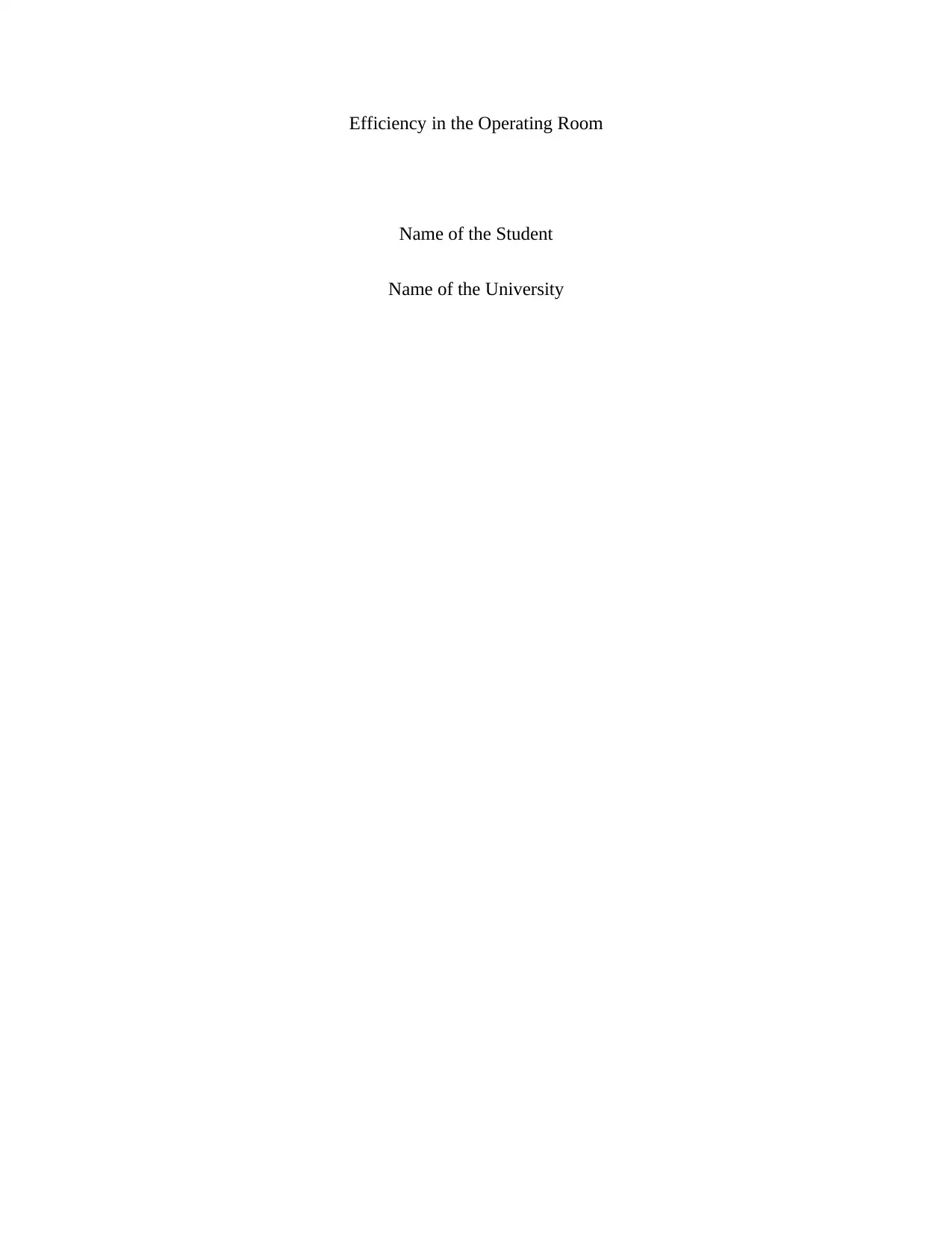
Efficiency in the Operating Room
Name of the Student
Name of the University
Name of the Student
Name of the University
Paraphrase This Document
Need a fresh take? Get an instant paraphrase of this document with our AI Paraphraser
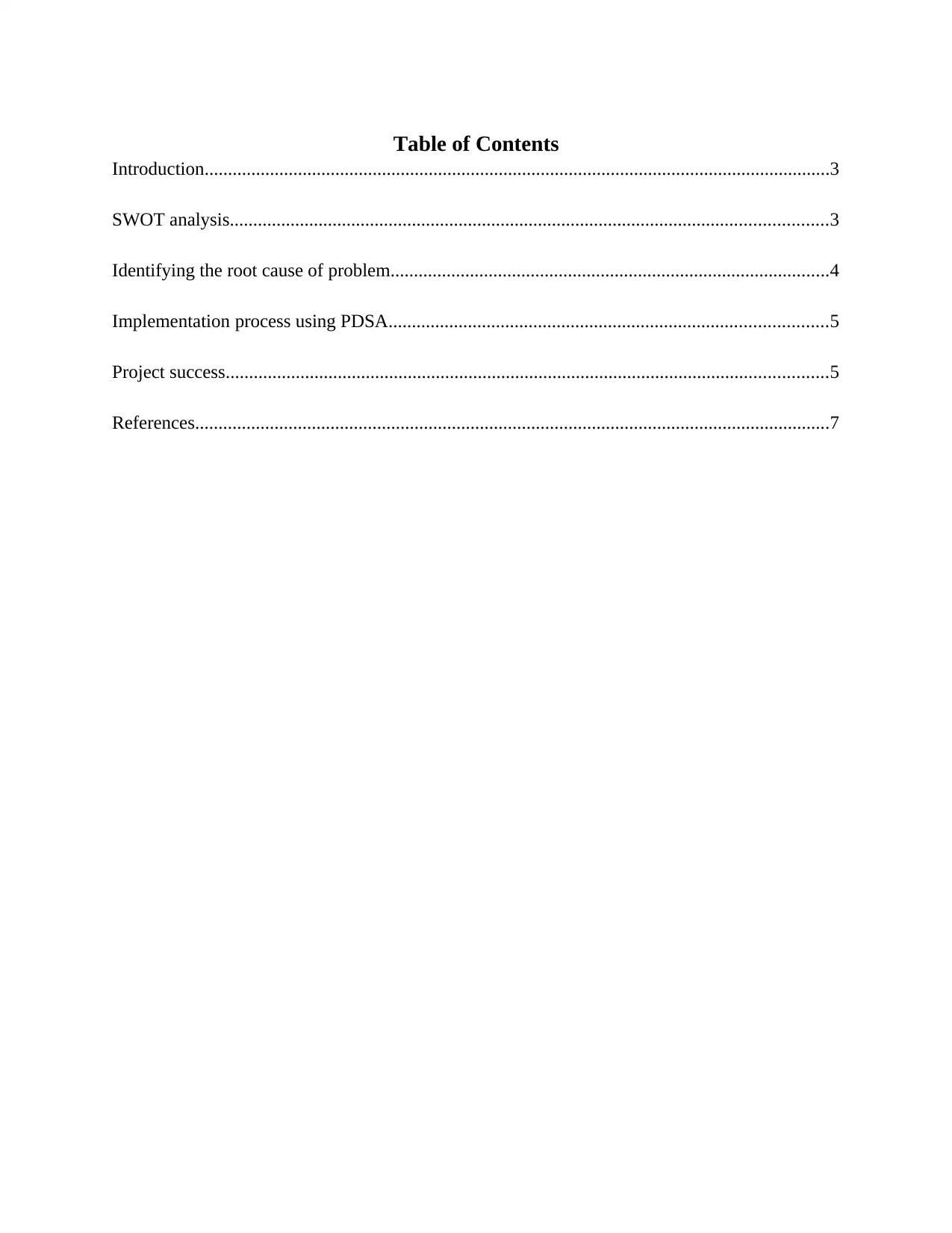
Table of Contents
Introduction......................................................................................................................................3
SWOT analysis................................................................................................................................3
Identifying the root cause of problem..............................................................................................4
Implementation process using PDSA..............................................................................................5
Project success.................................................................................................................................5
References........................................................................................................................................7
Introduction......................................................................................................................................3
SWOT analysis................................................................................................................................3
Identifying the root cause of problem..............................................................................................4
Implementation process using PDSA..............................................................................................5
Project success.................................................................................................................................5
References........................................................................................................................................7
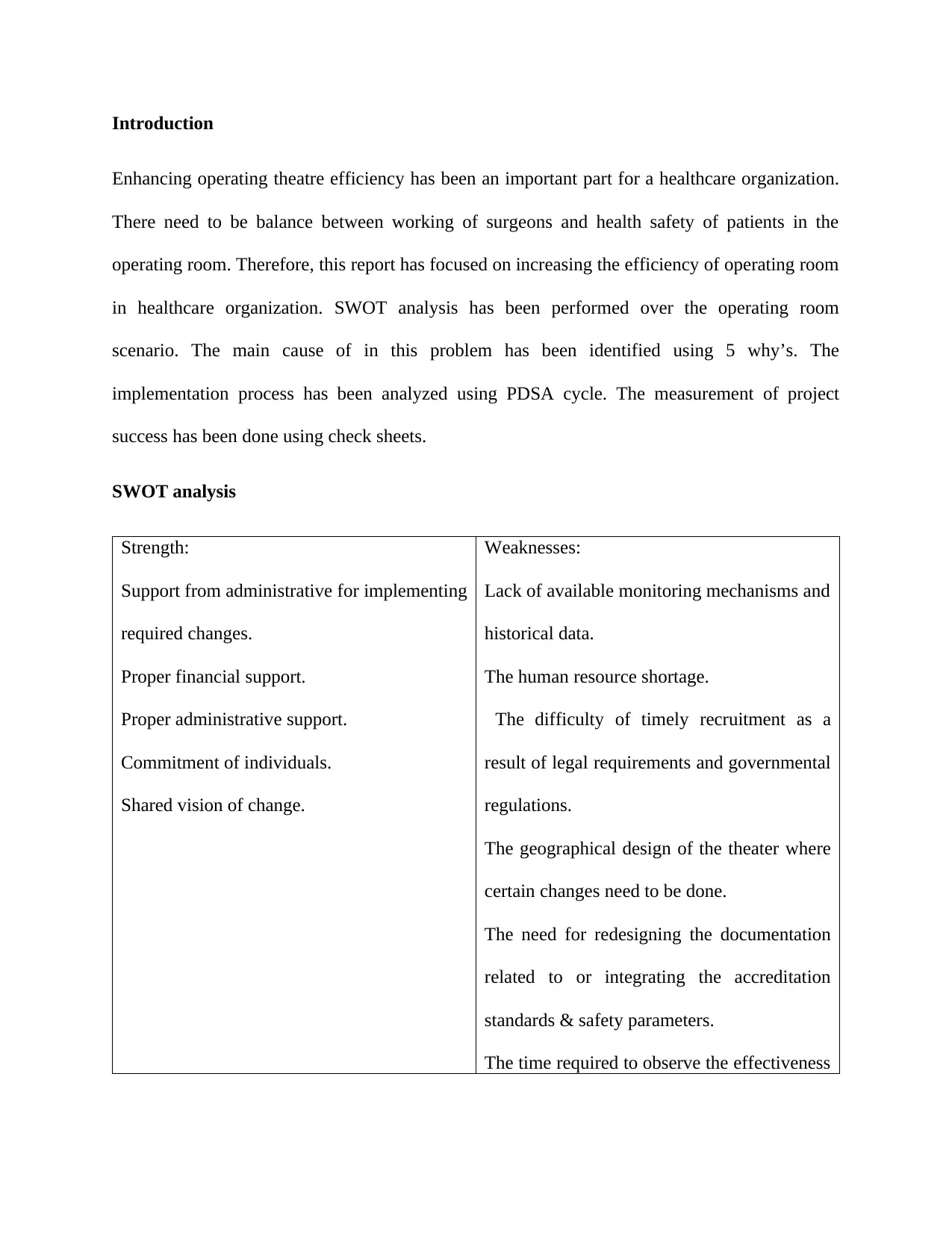
Introduction
Enhancing operating theatre efficiency has been an important part for a healthcare organization.
There need to be balance between working of surgeons and health safety of patients in the
operating room. Therefore, this report has focused on increasing the efficiency of operating room
in healthcare organization. SWOT analysis has been performed over the operating room
scenario. The main cause of in this problem has been identified using 5 why’s. The
implementation process has been analyzed using PDSA cycle. The measurement of project
success has been done using check sheets.
SWOT analysis
Strength:
Support from administrative for implementing
required changes.
Proper financial support.
Proper administrative support.
Commitment of individuals.
Shared vision of change.
Weaknesses:
Lack of available monitoring mechanisms and
historical data.
The human resource shortage.
The difficulty of timely recruitment as a
result of legal requirements and governmental
regulations.
The geographical design of the theater where
certain changes need to be done.
The need for redesigning the documentation
related to or integrating the accreditation
standards & safety parameters.
The time required to observe the effectiveness
Enhancing operating theatre efficiency has been an important part for a healthcare organization.
There need to be balance between working of surgeons and health safety of patients in the
operating room. Therefore, this report has focused on increasing the efficiency of operating room
in healthcare organization. SWOT analysis has been performed over the operating room
scenario. The main cause of in this problem has been identified using 5 why’s. The
implementation process has been analyzed using PDSA cycle. The measurement of project
success has been done using check sheets.
SWOT analysis
Strength:
Support from administrative for implementing
required changes.
Proper financial support.
Proper administrative support.
Commitment of individuals.
Shared vision of change.
Weaknesses:
Lack of available monitoring mechanisms and
historical data.
The human resource shortage.
The difficulty of timely recruitment as a
result of legal requirements and governmental
regulations.
The geographical design of the theater where
certain changes need to be done.
The need for redesigning the documentation
related to or integrating the accreditation
standards & safety parameters.
The time required to observe the effectiveness
⊘ This is a preview!⊘
Do you want full access?
Subscribe today to unlock all pages.

Trusted by 1+ million students worldwide
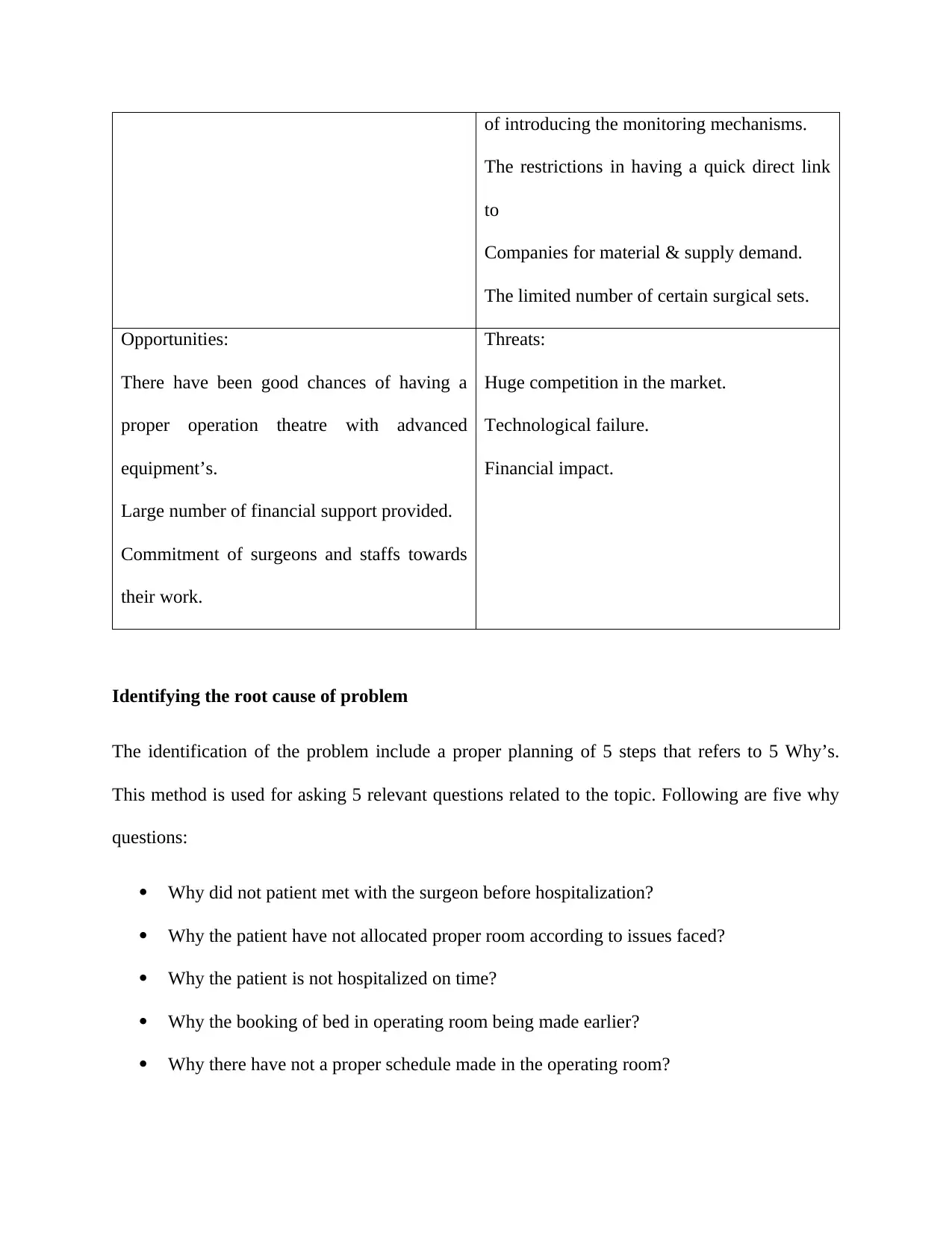
of introducing the monitoring mechanisms.
The restrictions in having a quick direct link
to
Companies for material & supply demand.
The limited number of certain surgical sets.
Opportunities:
There have been good chances of having a
proper operation theatre with advanced
equipment’s.
Large number of financial support provided.
Commitment of surgeons and staffs towards
their work.
Threats:
Huge competition in the market.
Technological failure.
Financial impact.
Identifying the root cause of problem
The identification of the problem include a proper planning of 5 steps that refers to 5 Why’s.
This method is used for asking 5 relevant questions related to the topic. Following are five why
questions:
Why did not patient met with the surgeon before hospitalization?
Why the patient have not allocated proper room according to issues faced?
Why the patient is not hospitalized on time?
Why the booking of bed in operating room being made earlier?
Why there have not a proper schedule made in the operating room?
The restrictions in having a quick direct link
to
Companies for material & supply demand.
The limited number of certain surgical sets.
Opportunities:
There have been good chances of having a
proper operation theatre with advanced
equipment’s.
Large number of financial support provided.
Commitment of surgeons and staffs towards
their work.
Threats:
Huge competition in the market.
Technological failure.
Financial impact.
Identifying the root cause of problem
The identification of the problem include a proper planning of 5 steps that refers to 5 Why’s.
This method is used for asking 5 relevant questions related to the topic. Following are five why
questions:
Why did not patient met with the surgeon before hospitalization?
Why the patient have not allocated proper room according to issues faced?
Why the patient is not hospitalized on time?
Why the booking of bed in operating room being made earlier?
Why there have not a proper schedule made in the operating room?
Paraphrase This Document
Need a fresh take? Get an instant paraphrase of this document with our AI Paraphraser
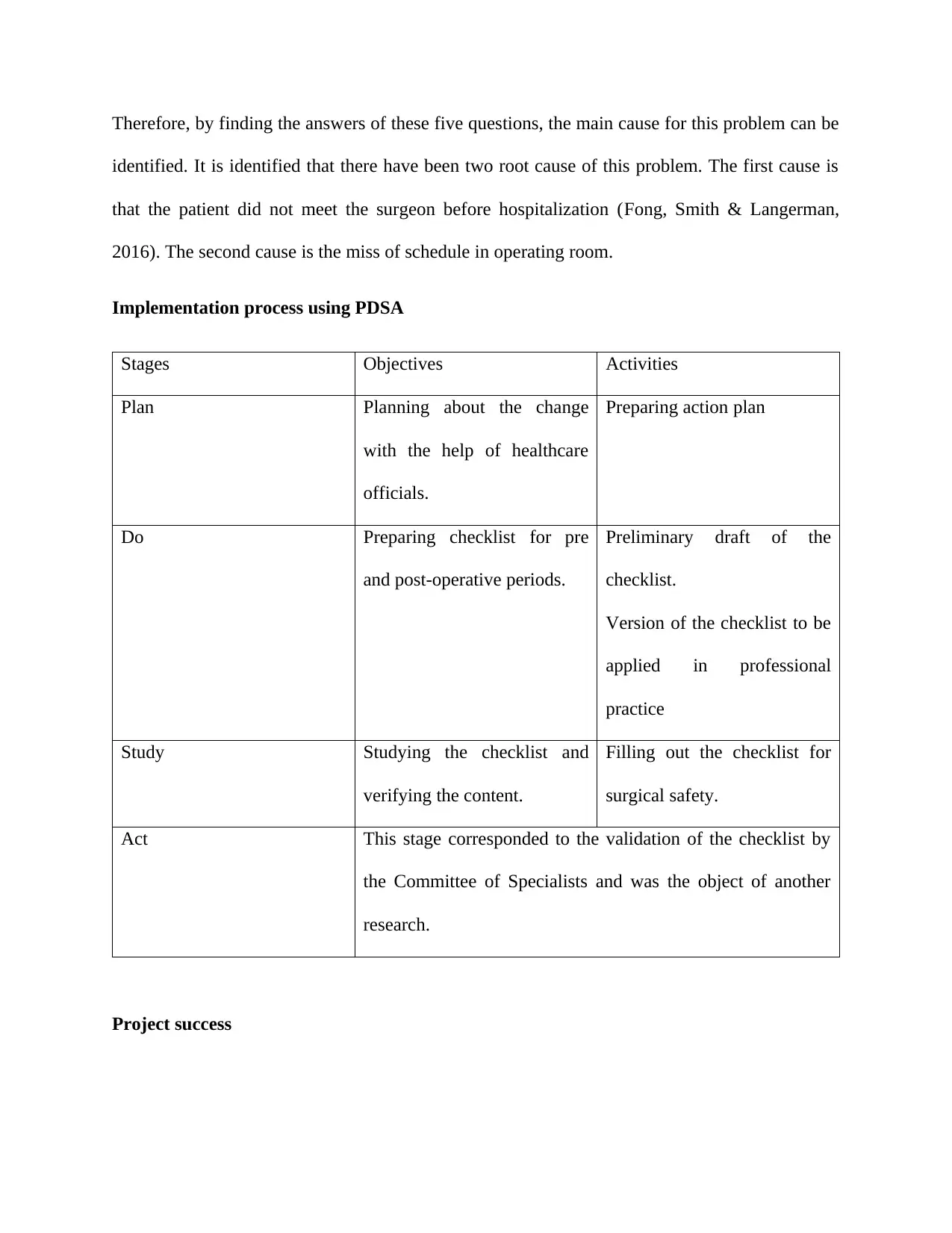
Therefore, by finding the answers of these five questions, the main cause for this problem can be
identified. It is identified that there have been two root cause of this problem. The first cause is
that the patient did not meet the surgeon before hospitalization (Fong, Smith & Langerman,
2016). The second cause is the miss of schedule in operating room.
Implementation process using PDSA
Stages Objectives Activities
Plan Planning about the change
with the help of healthcare
officials.
Preparing action plan
Do Preparing checklist for pre
and post-operative periods.
Preliminary draft of the
checklist.
Version of the checklist to be
applied in professional
practice
Study Studying the checklist and
verifying the content.
Filling out the checklist for
surgical safety.
Act This stage corresponded to the validation of the checklist by
the Committee of Specialists and was the object of another
research.
Project success
identified. It is identified that there have been two root cause of this problem. The first cause is
that the patient did not meet the surgeon before hospitalization (Fong, Smith & Langerman,
2016). The second cause is the miss of schedule in operating room.
Implementation process using PDSA
Stages Objectives Activities
Plan Planning about the change
with the help of healthcare
officials.
Preparing action plan
Do Preparing checklist for pre
and post-operative periods.
Preliminary draft of the
checklist.
Version of the checklist to be
applied in professional
practice
Study Studying the checklist and
verifying the content.
Filling out the checklist for
surgical safety.
Act This stage corresponded to the validation of the checklist by
the Committee of Specialists and was the object of another
research.
Project success
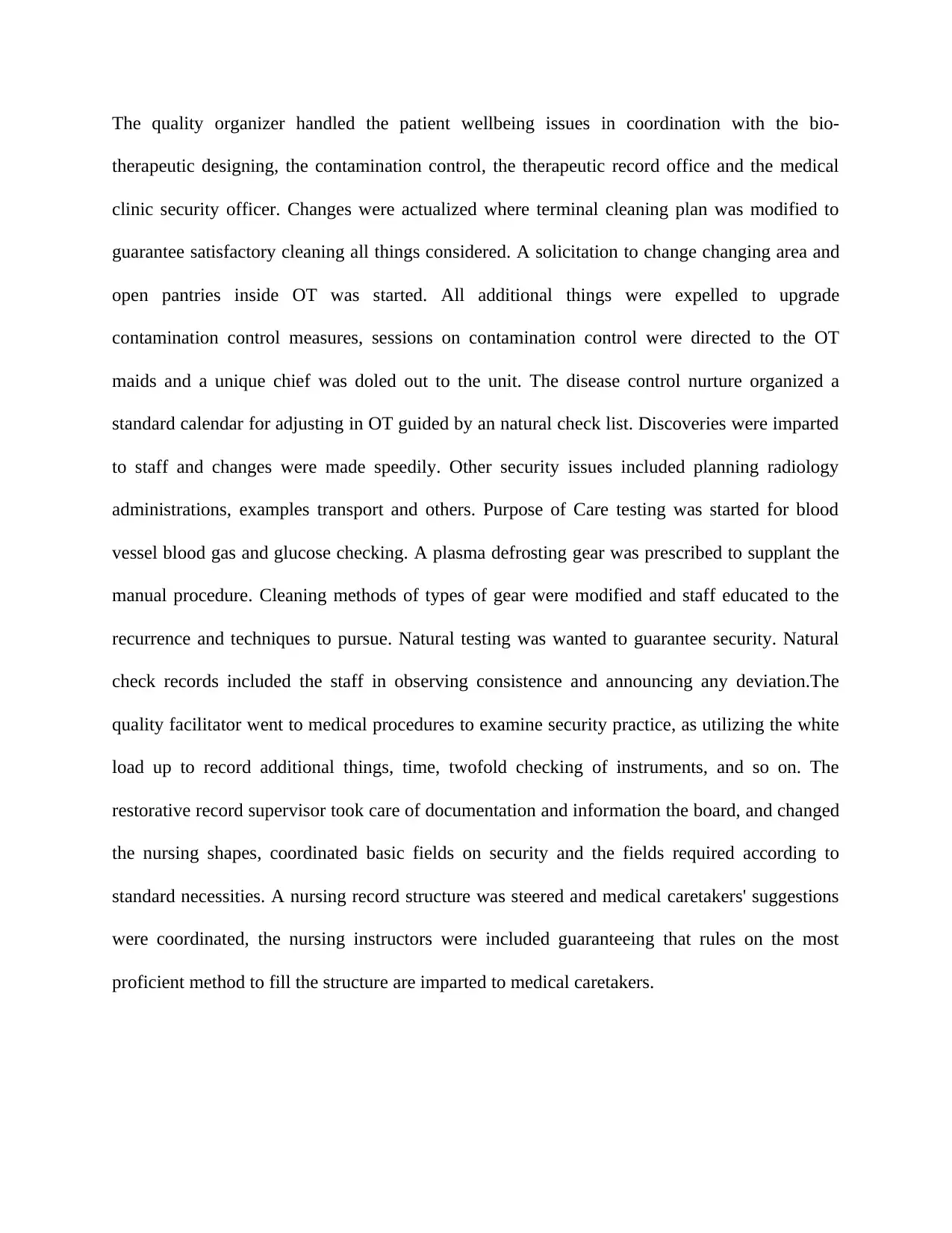
The quality organizer handled the patient wellbeing issues in coordination with the bio-
therapeutic designing, the contamination control, the therapeutic record office and the medical
clinic security officer. Changes were actualized where terminal cleaning plan was modified to
guarantee satisfactory cleaning all things considered. A solicitation to change changing area and
open pantries inside OT was started. All additional things were expelled to upgrade
contamination control measures, sessions on contamination control were directed to the OT
maids and a unique chief was doled out to the unit. The disease control nurture organized a
standard calendar for adjusting in OT guided by an natural check list. Discoveries were imparted
to staff and changes were made speedily. Other security issues included planning radiology
administrations, examples transport and others. Purpose of Care testing was started for blood
vessel blood gas and glucose checking. A plasma defrosting gear was prescribed to supplant the
manual procedure. Cleaning methods of types of gear were modified and staff educated to the
recurrence and techniques to pursue. Natural testing was wanted to guarantee security. Natural
check records included the staff in observing consistence and announcing any deviation.The
quality facilitator went to medical procedures to examine security practice, as utilizing the white
load up to record additional things, time, twofold checking of instruments, and so on. The
restorative record supervisor took care of documentation and information the board, and changed
the nursing shapes, coordinated basic fields on security and the fields required according to
standard necessities. A nursing record structure was steered and medical caretakers' suggestions
were coordinated, the nursing instructors were included guaranteeing that rules on the most
proficient method to fill the structure are imparted to medical caretakers.
therapeutic designing, the contamination control, the therapeutic record office and the medical
clinic security officer. Changes were actualized where terminal cleaning plan was modified to
guarantee satisfactory cleaning all things considered. A solicitation to change changing area and
open pantries inside OT was started. All additional things were expelled to upgrade
contamination control measures, sessions on contamination control were directed to the OT
maids and a unique chief was doled out to the unit. The disease control nurture organized a
standard calendar for adjusting in OT guided by an natural check list. Discoveries were imparted
to staff and changes were made speedily. Other security issues included planning radiology
administrations, examples transport and others. Purpose of Care testing was started for blood
vessel blood gas and glucose checking. A plasma defrosting gear was prescribed to supplant the
manual procedure. Cleaning methods of types of gear were modified and staff educated to the
recurrence and techniques to pursue. Natural testing was wanted to guarantee security. Natural
check records included the staff in observing consistence and announcing any deviation.The
quality facilitator went to medical procedures to examine security practice, as utilizing the white
load up to record additional things, time, twofold checking of instruments, and so on. The
restorative record supervisor took care of documentation and information the board, and changed
the nursing shapes, coordinated basic fields on security and the fields required according to
standard necessities. A nursing record structure was steered and medical caretakers' suggestions
were coordinated, the nursing instructors were included guaranteeing that rules on the most
proficient method to fill the structure are imparted to medical caretakers.
⊘ This is a preview!⊘
Do you want full access?
Subscribe today to unlock all pages.

Trusted by 1+ million students worldwide
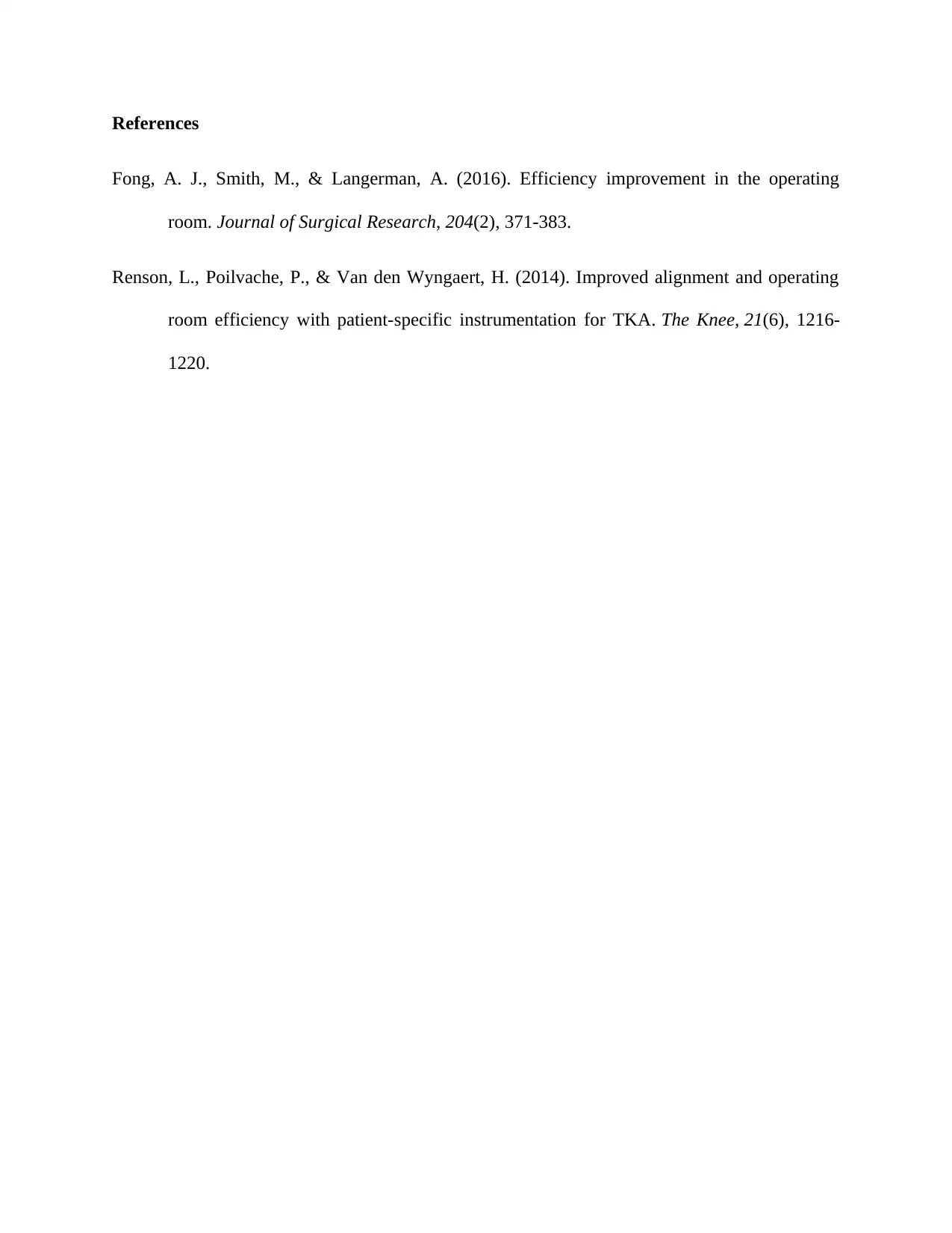
References
Fong, A. J., Smith, M., & Langerman, A. (2016). Efficiency improvement in the operating
room. Journal of Surgical Research, 204(2), 371-383.
Renson, L., Poilvache, P., & Van den Wyngaert, H. (2014). Improved alignment and operating
room efficiency with patient-specific instrumentation for TKA. The Knee, 21(6), 1216-
1220.
Fong, A. J., Smith, M., & Langerman, A. (2016). Efficiency improvement in the operating
room. Journal of Surgical Research, 204(2), 371-383.
Renson, L., Poilvache, P., & Van den Wyngaert, H. (2014). Improved alignment and operating
room efficiency with patient-specific instrumentation for TKA. The Knee, 21(6), 1216-
1220.
1 out of 7
Related Documents
Your All-in-One AI-Powered Toolkit for Academic Success.
+13062052269
info@desklib.com
Available 24*7 on WhatsApp / Email
![[object Object]](/_next/static/media/star-bottom.7253800d.svg)
Unlock your academic potential
Copyright © 2020–2025 A2Z Services. All Rights Reserved. Developed and managed by ZUCOL.





